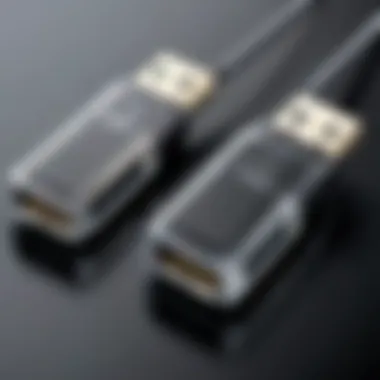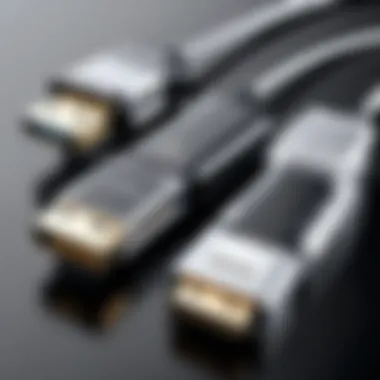Understanding the Double USB Connector: Features and Benefits


Intro
In today’s hyper-connected world, the need for efficient, versatile charging solutions has never been greater. The double USB connector stands at the forefront of this demand, offering a practical answer to problems faced by both consumers and professionals alike. As technology evolves, these connectors have become crucial for powering various devices, enhancing usability, and supporting simultaneous data transfer and charging.
This article aims to dissect the double USB connector, shedding light on its key features, technical specifications, performance analysis, and real-world applications. By understanding these elements, IT professionals and tech enthusiasts can make informed decisions about utilizing double USB connectors in their devices and infrastructure.
Product Overview
Key Features
Double USB connectors are characterized by their ability to accommodate two separate USB ports in a single unit. This feature significantly increases functionality, allowing users to charge multiple devices or transfer data concurrently.
Some essential features include:
- Dual Functionality: Enables simultaneous charging and data transfer.
- Universal Compatibility: Compatible with various USB standards, including USB-A and USB-C.
- Compact Design: Its small size allows easy integration into various devices without excessive bulk.
- High Power Output: Supports faster charging with high wattage ratings.
Technical Specifications
The technical specification of double USB connectors can vary based on type. However, some common attributes include:
- Data Transfer Rates: Typically ranges from USB 2.0 (480 Mbps) to USB 3.2 (10 Gbps or higher).
- Voltage and Current Ratings: Supports up to 5V and 3A or more, depending on power requirements.
- Material Durability: Often constructed with high-quality materials to withstand wear and tear.
Performance Analysis
Benchmark Test Results
Performance assessments reveal that double USB connectors deliver consistent results under various scenarios. In benchmark tests, devices with double USB connectors showcase enhanced efficiency when compared to traditional single connectors. Test results typically indicate better data transfer rates and reduced charging times.
Real-World Usage Scenarios
In practical settings, the utility of double USB connectors becomes apparent:
- Mobile Devices: Smartphones and tablets often utilize double USB connectors for fast charging alongside data management, such as file transfers or syncing with computers.
- Laptops and PCs: Many modern laptops come equipped with double USB ports, facilitating connections for peripherals like external keyboards, mice, and storage devices without compromising power supply.
- Smart Home Devices: Increased adoption in smart home devices allows seamless integration into various systems, improving convenience.
The double USB connector is transforming how we interact with technology by enhancing versatility while meeting charging needs effectively.
Intro to Double USB Connectors
The double USB connector plays a crucial role in today’s technological landscape, serving as a foundational element in the design and functionality of modern electronic devices. As the demand for efficient charging solutions rises, understanding this component becomes increasingly important for IT professionals and tech enthusiasts. The versatility and efficiency offered by double USB connectors are not only advantageous for consumer electronics but also for various industrial and commercial applications.
Definition and Evolution
The double USB connector is a physical interface designed to accommodate two USB ports within a single connector design. This innovation allows users to connect multiple devices while utilizing limited space. Originally, USB technology began as a simple means of connecting devices like keyboards and mice to personal computers. Through the years, innovations led to the development of various USB standards, notably USB 2.0, USB 3.0, and the more recent USB-C standard. As speeds increased and the demand for charging capabilities grew, the double USB connector evolved to integrate these advancements. This design not only enhances usability but also improves overall connectivity efficiency.
Importance in Modern Technology


The significance of double USB connectors extends beyond mere convenience. These connectors have become essential in reducing clutter and enhancing the overall user experience across diverse devices. In modern technology, having the ability to charge multiple devices simultaneously without the need for numerous adapters or ports simplifies daily interactions with technology. This is particularly valuable for professionals who rely on several devices daily.
Moreover, double USB connectors facilitate the growing trend of rapid charging, which has become a standard expectation among consumers. With the integration of advanced charging technologies, these connectors can support faster data transfer rates and higher power outputs, effectively addressing the demands of present-day electronics.
"The double USB connector exemplifies a design philosophy centered on efficiency, addressing both charging and connectivity needs simultaneously."
In summary, understanding the double USB connector is essential for appreciating its role and impact in modern technology. With ongoing advancements, the relevance of these connectors will only increase.
Technical Specifications
The examination of technical specifications is vital for understanding double USB connectors. These specifications not only dictate the performance of the connectors but also influence their application in various fields. Knowing the technical details helps IT professionals and tech enthusiasts choose the right connector for specific needs, balancing factors like speed, compatibility, and power.
Connector Types and Standards
Double USB connectors come in several types, with the most common being USB Type-A and USB Type-C. USB Type-C has gained popularity due to its reversible design and higher power capabilities. It supports a versatile range of applications, making it suitable for both power delivery and data transfer.
Standards such as USB 2.0, USB 3.0, and USB 3.1 define the capabilities and use cases for these connectors. Each standard offers different levels of performance:
- USB 2.0 provides a maximum data transfer rate of 480 Mbps.
- USB 3.0 increases this capacity to 5 Gbps.
- USB 3.1 further expands it to up to 10 Gbps, enabling faster data movement.
Understanding these types and standards will help users select the appropriate connector for their devices, making it essential for those in technology.
Data Transfer Rates
Data transfer rates are a significant criterion when analyzing double USB connectors. The higher the data rate, the quicker the files can be transferred, enhancing overall efficiency. As applications become more demanding, including high-definition video and large software files, the need for faster transfer means selecting connectors that support USB 3.0 or above.
For example, USB 3.1 connectors can handle large datasets much faster than USB 2.0. This is particularly beneficial in professional fields like video production and cloud solutions, where time-saving is key.
Power Output and Charging Capabilities
Power output and charging capabilities are also critical factors to consider. Double USB connectors can deliver various power amounts depending on the standard. USB Power Delivery (PD) allows for adjustable voltage and current, enabling faster charging for devices with higher energy demands.
A typical USB Type-C connector can provide up to 100 watts of power, allowing users to charge laptops, tablets, and smartphones efficiently. This is a significant advancement compared to older standards, which typically offered lower power rates. With devices becoming more advanced, the ability to provide higher power through double USB connectors is increasingly important.
Advantages of Double USB Connectors
The advantages of double USB connectors are numerous and significant, reflecting their relevance in today’s technology landscape. These connectors offer enhanced functionality and convenience that is appealing to both manufacturers and users. By examining these benefits critically, we can appreciate why double USB connectors have become a standard feature in many devices.
Dual Charging Options
One of the primary advantages of double USB connectors is the ability to provide dual charging options. This feature allows users to charge two devices simultaneously. For instance, a smartphone and a tablet can be charged at the same time from one power source. This efficiency not only saves time but also reduces the need for multiple outlets and chargers. As devices proliferate, charging options become crucial. Users often carry several gadgets, and the convenience of a double USB connector can streamline everyday charging tasks.
Moreover, in an environment like a car or home office where space is limited, this capability becomes even more relevant. Users no longer have to sacrifice one device's charge for another. Instead, they can stay connected effortlessly.
Enhanced Compatibility


Another noteworthy aspect of double USB connectors is their enhanced compatibility with various devices. USB ports are now ubiquitous, found in smartphones, laptops, cameras, and numerous other electronics. The flexibility offered by double USB connectors means they can adapt to varying USB standards, including USB 2.0, USB 3.0, and more recent iterations like USB-C.
This adaptability helps companies leverage existing infrastructure without completely retooling systems. For device manufacturers, this reduces production costs and simplifies product design. For consumers, it means that they can rely on a single universal charging solution that works across many devices, reducing confusion about which charger to use with each device.
Space and Cable Management
The aspect of space and cable management cannot be understated. Double USB connectors eliminate the clutter that often arises from multiple charging cables. With a singular connector serving multiple devices, users can enjoy a cleaner workspace. This is particularly beneficial in environments where aesthetics and organization are important, such as in creative studios or professional offices.
Effective cable management has been shown to improve productivity in workspaces.
By using double USB connectors, fewer cables lead to fewer tangles and less wasted time untangling cords. Furthermore, many modern double USB connectors come with features like retractable cables or built-in organizers, enhancing the user experience even more. This means that not only do users get the functionality, but they also benefit from the simplicity of use and maintenance which contributes to overall satisfaction with their devices.
Applications of Double USB Connectors
The application of double USB connectors is vital in the modern technological landscape. These connectors have become increasingly prevalent across various sectors. Their growing importance stems from the need for efficient charging and data transfer solutions. By analyzing the diverse applications, we can appreciate how double USB connectors enhance functionality in numerous devices and environments.
Consumer Electronics
In modern consumer electronics, double USB connectors simplify user experiences. Devices like smartphones, tablets, and laptops now often include these connectors. This feature allows users to simultaneously charge two devices or transfer data at high speeds. For instance, when using a double USB charger, one can power a smartphone while simultaneously recharging a smartwatch. This convenience improves daily efficiency and meets the fast-paced demands of today's lifestyle.
Moreover, many home appliances, such as smart TVs or gaming consoles, also utilize double USB connectors. They provide seamless connectivity for additional peripherals. With the integration of these connectors, consumers benefit from a more organized and efficient environment. Compatibility with various devices, ranging from power banks to portable speakers, makes these connectors essential for consumers.
Automotive Technology
Double USB connectors are also rapidly becoming standard in automotive technology. As vehicles integrate more advanced infotainment systems, the need for connectivity options increases. With double USB ports, users can easily connect multiple devices such as smartphones and tablets during travel. This capability enhances entertainment options and offers quick access to charging for devices on the go.
Digital technology in vehicles often requires extensive data transfer capabilities. Double USB connectors help manage this demand, ensuring that both power and data are transmitted efficiently. Many modern cars incorporate these connectors into their dashboards, offering an intuitive way for passengers to charge and use their devices. The practicality of double USB connectors in this context extends beyond convenience; it represents a step towards the future of connected mobility.
Industrial and Commercial Use Cases
In industrial and commercial settings, double USB connectors prove indispensable. They facilitate power and data transfer in various applications, from factory automation to corporate environments. For example, in a manufacturing plant, machines that require sensor connections can benefit from the dual functionality of double USB connectors. This enables easier integration of hardware and improves efficiency during operations.
Furthermore, these connectors are used in point-of-sale (POS) systems. Retail businesses can connect multiple devices, like barcode scanners and tablets, through one compact connector, streamlining transactions and enhancing customer service. The versatility of double USB connectors in commercial applications enhances workflow and ensures that businesses keep pace with technological advancements.
When designing devices for various applications, having double USB connectors can enhance user functionality and improve overall efficiency.
In summary, the applications of double USB connectors span numerous sectors, improving efficiency and user convenience. Whether in consumer electronics, automotive technology, or industrial applications, these connectors are integral to maintaining an advanced technological ecosystem. Their adaptability and convenience ensure that they will remain a staple in future developments.
Compatibility Considerations
In the realm of technology, compatibility is often the linchpin for successful integration and effective usage. The double USB connector, designed for versatility and efficiency, exhibits a range of compatibility considerations that merit thorough examination. Compatibility not only affects performance but also influences user experience. Understanding these aspects is crucial for IT professionals and tech enthusiasts looking to maximize the utility of double USB connectors across various devices and platforms.
Device Compatibility Challenges
One significant challenge with double USB connectors is ensuring that they work seamlessly across different devices. Various manufacturers often utilize unique designs or specifications for their ports. This variability can lead to instances where certain devices cannot interact with a double USB connector. Industry standards attempt to alleviate these anxieties, yet users may still encounter obstacles when trying to bridge connections between legacy devices and newer models.


When considering device compatibility, it is essential to take into account:
- Connector Types: Not all USB connectors are the same. Different models—like USB Type-A, Type-B, Micro-USB, and USB-C—vary in size and pin configuration. A mismatch can render a connection futile.
- Device Requirements: Some devices have unique power requirements. If the connector cannot provide the necessary power output, the device may not function correctly or may charge slowly.
- Firmware Updates: Compatibility issues can sometimes stem from outdated software. Regular updates are crucial for ensuring devices recognize and efficiently use double USB connectors.
USB Version Compatibility
Another layer to compatibility considerations is the versioning of USB standards. Each iteration of USB brings advancements in speed, power delivery, and overall functionality. The double USB connector may support multiple versions, such as USB 2.0, 3.0, or even the latest USB 3.2. However, connecting a device that utilizes an earlier version to a newer USB connector can present difficulties.
Key points regarding USB version compatibility include:
- Speed Limitations: Connecting a USB 3.0 device to a USB 2.0 connector will restrict the data transfer rates to the lower standard.
- Power Delivery Specifications: Different versions support varying levels of power delivery. Understanding these specifications can prevent charging issues and potential damage.
- Backward Compatibility: Generally, USB specifications are designed with backward compatibility in mind, allowing older devices to work with newer connectors, but this is not universally guaranteed. IT professionals must be vigilant to avoid compatibility pitfalls.
"A thorough understanding of compatibility considerations ensures the effective utilization of double USB connectors across a wide range of devices and user scenarios."
Market Trends and Future Developments
In the rapidly evolving landscape of technology, double USB connectors are at the forefront, adapting to changing demands in the market. Understanding both the market trends and future developments is vital for IT professionals and tech enthusiasts. It allows them to stay informed about potential innovations that can enhance efficiency and functionality in various applications.
Emerging Technologies
The development of new technologies often influences the design and functionality of double USB connectors. Recent innovations include advancements in USB Power Delivery and USB4.
- USB Power Delivery enables higher power efficiency and faster charging times by negotiating power needs between connected devices. This capability is especially relevant as consumer devices demand more power while maintaining compact sizes.
- USB4, introduced with greater speeds and data capacity, is a single connector standard that supports multiple protocols, including Thunderbolt 3. This will unify device connectivity, promoting interoperability.
The integration of these technologies within double USB connectors indicates a shift towards more versatile and efficient solutions. As manufacturers adopt these standards, users will benefit from improved performance.
Consumer Demand Analysis
Consumer behavior is significantly shaping the direction of double USB connector technologies. Analyzing current demand trends sheds light on future developments.
- There is an abundant demand for fast charging solutions, as users increasingly expect their devices to charge quickly without sacrificing portability.
- The rise of IoT devices has led to an increase in the need for multiple connections. Double USB connectors address this by allowing simultaneous charging and data transfer for multiple devices, streamlining user experiences.
- Sustainability is becoming a key consideration. Consumers are more inclined towards eco-friendly products. This trend prompts manufacturers to prioritize sustainable materials and designs in connector production.
As technology continues to advance, the need for double USB connectors will likely grow, leading manufacturers to innovate further to meet user demands.
Staying abreast of these trends helps businesses make informed decisions. A well-informed strategy can accommodate technological innovations and evolving consumer preferences.
Culmination
The conclusion of this article encapsulates the significance of double USB connectors within the realm of connectivity technology. These connectors serve not only as functional components in device charging and data transfer but also as a critical factor in optimizing user experience. As technology advances, the relevance of these connectors continues to grow, making it paramount to understand their features, advantages, and various applications.
Summary of Key Insights
To summarize, double USB connectors present a myriad of benefits that enhance both personal and professional electronic interactions. Key insights include:
- Versatility: Their ability to support charging for multiple devices simultaneously addresses modern consumer needs, where multiple gadgets are commonplace.
- Compatibility: The standardization across various devices ensures a seamless user experience, alleviating concerns with device connectivity.
- Future-Proofing: As USB standards evolve, the double USB connector's adaptability will remain vital, catering to new technologies and consumer demands.
"Double USB connectors are more than a trend; they indicate a strategic response to the growing complexity of our digital lives."
Recommendations for Implementation
For IT professionals and tech enthusiasts considering the integration of double USB connectors in their projects, several recommendations are essential:
- Assess Compatibility: Before implementation, ensure that the connectors align with the devices in use, taking note of USB version specifications.
- Analyze Power Requirements: Understand the power output needed for devices to avoid underperformance or charging conflicts. Utilizing connectors like the Anker PowerPort III or Belkin Boost Up can optimize charging efficiency.
- Stay Informed on Standards: As USB technology advances, being aware of emerging standards, such as USB 4.0, will be crucial for future implementations.
- Design for User Experience: Prioritize user-friendliness in the design of devices that incorporate double USB connectors to enhance engagement and satisfaction.



